This article on the E7 chord explains its music theory and teaches you to play the common voicings of the chord on the guitar and piano keyboard with recommended fingering options.
Read the complete article on how to play the E7 chord below!
Music Theory, Notes & Intervals Of The E7 Chord
The music theory of the E7 chord, in brief, is:
- It is built by stacking an interval of a minor third over the E major triad.
- The dominant 7th chord has intervals of major third – minor third – minor third over the root notes.
- The notes of the E7 chord are [E, G#, B, and D]. These notes are at the scale degrees [5, 7, 2, and 4] of the A major key.
E7 Chord Scales
The following scales contain the E7 dominant chord as a naturally occurring chord:
- A Major Scale and its modes.
- A Melodic Minor Scale and its modes.
- B Melodic Minor scale and its modes.
- A Harmonic Minor scale and its modes.
- A Harmonic Major scale and its modes.
How To Play The E7 Chord
You will now learn how to play the E7 guitar and E7 piano chords.
Map E7 Guitar Chord Along All The Fretboard
The chord tones of the E7 guitar chords in standard tuning are shown on the fretboard in the diagram below.
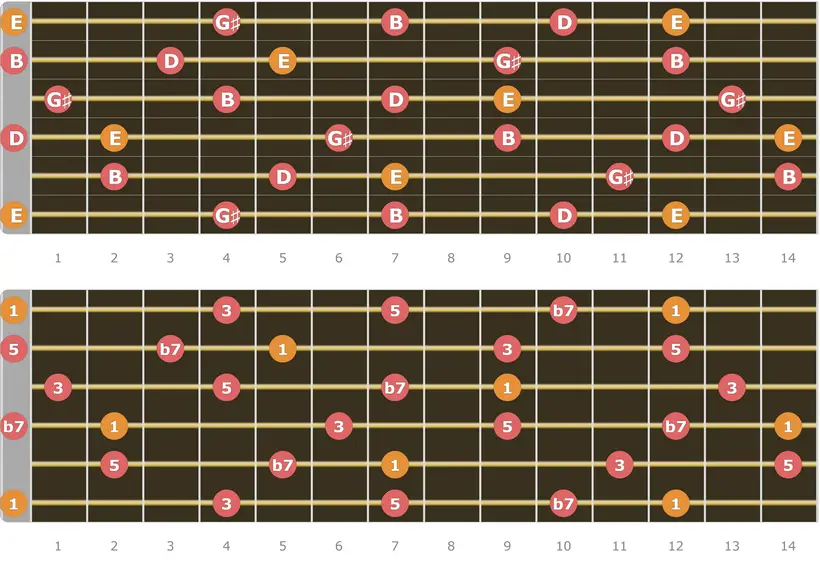
E Dominant Seventh Chord – Guitar Chord Shapes And Fingerings
You can go through the various ways to play the E7 guitar chord in the guitar chord diagrams below. Like other guitar chords, you can play E7 in open, movable, and barre chord shapes. The red circles show the suggested finger positions, and the black circles show the fret numbers. The strings marked ‘X’ must be muted or skipped, while ‘O’ must be played in the open position.
Open Position
The open voicings of the E7 chord are detailed below in all the positions up to the octave.
- O1 – Construction – (x – x – 2 – 1 – 3 – 0). Notes – (1, 3, b7, and 1). This shape has an omitted 5th note. The lowest root note is on the D string
- O2 – Construction – (0 – 2 – 0 – 1 – 0 – 0). Notes – (1, 5, b7, 3, 5, and 1). The lowest root is the open low e string.
- O3 – Construction – (x – 2 – 0 – 1 – 3 – 0). Notes – (5, b7, 3, b7, and 1). B is the bass note.
- O4 – Construction – (0 – 2 – 0 – 1 – 3 – 0). Notes – (1, 5, b7, 3, b7, and 1).
- O5 – Construction – (0 – 2 – 2 – 1 – 3 – 0). Notes – (1, 5, 1, 3, b7, and 1).
- O6 – Construction – (0 – 5 – x – x – x – x). Notes – (1 and b7). 3rd and 5th are omitted.
- O7 – Construction – (0 – x – 6 – 7 – x – x). Notes – (1, 3, and b7). 5th is omitted.
- O8 – Construction – (0 – 7 – 6 – 7 – 5 – 0). Notes – (1, 1, 3, b7, 1, and 1). 5th is omitted.
- O9 – Construction – (0 – 7 – 6 – 7 – 0 – 7). Notes – (1, 1, 3, b7, 5, and 5).
- O10 – Construction – (x – 7 – x – 7 – 9 – 7). Notes – (1, b7, 3, and 1). 5th is omitted.
O1
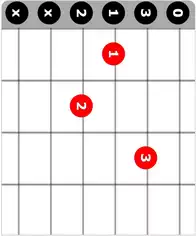
O2
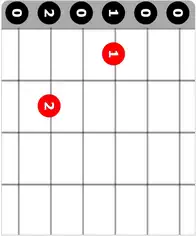
O3
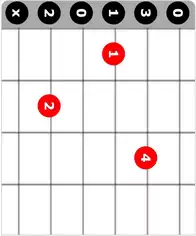
O4
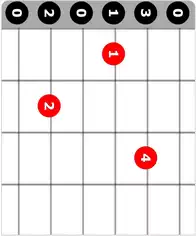
O5
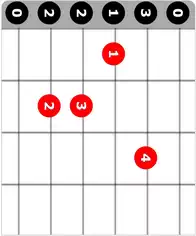
O6
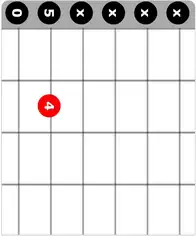
O7
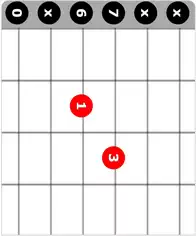
O8
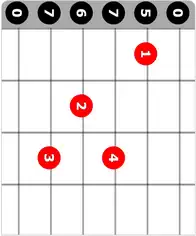
O9
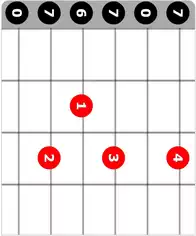
O10
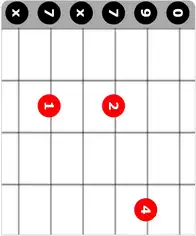
Movable Positions
The eight voicings to play guitar movable shapes are shown below.
- M1 – Construction – (x – x – x – 4 – 3 – 4). Notes – (5, b7, and 3). This is a rootless voicing.
- M2 – Construction – (4 – x – 2 – 4 – 3 – x). Notes – (3, 1, 5, and b7).
- M3 – Construction – (x – x – 2 – 4 – 3 – 4). Notes – (1, 5, b7, and 3).
- M4 – Construction – (x – 7 – 6 – 7 – 5 – x). Notes – (1, 3, b7, and 1). 5th is omitted.
- M5 – Construction – (x – 7 – 6 – 7 – x – x). Notes – (1, 3, and b7). 5th is omitted.
- M6 – Construction – (x – 7 – 6 – 7 – x – 7). Notes – (1, 3, b7, and 5).
- M7 – Construction – (x – x – 6 – 7 – 5 – 7). Notes – (3, b7, 1, and 5).
- M8 – Construction – (12 – x – 12 – 13 – 12 – x). Notes – (1, b7, 3, and 5).
M1
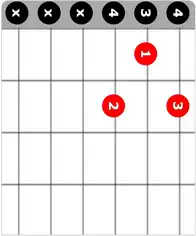
M2
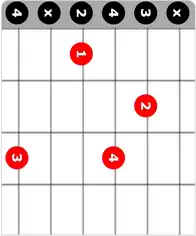
M3
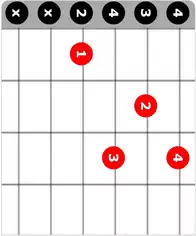
M4
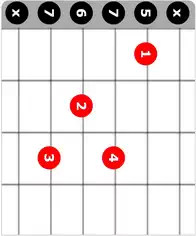
M5
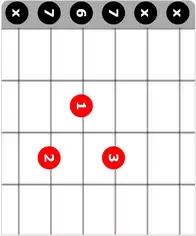
M6
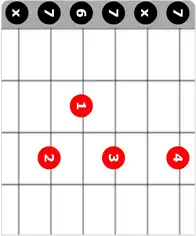
M7
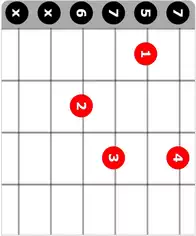
M8
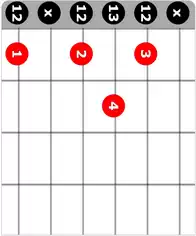
Barre Chords
The seven Barre chord shapes for the E7 chord are
- B1 – (1, 1, 5, b7, 3, and 5). This shape uses the open low e string also.
- B2 – (1, 5, b7, 3, and 5).
- B3 – (1, b7, 3, and 5).
- B4 – (1, 3, and b7).
- B5 – (5, 1, 3, and b7). B is the root note. This is a very common voicing with the minor seventh note on the high e-string.
- B6 – (b7, 3, 5, and 1).
- B7 – (1, 5, b7, 3, 5, and 1). Note that this shape is based on the open E7 shape shown as O2 above.
B1
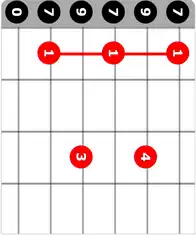
B2
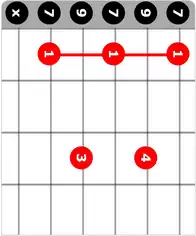
B3
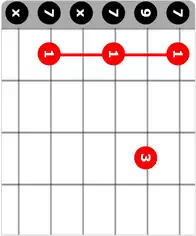
B4
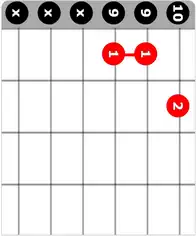
B5
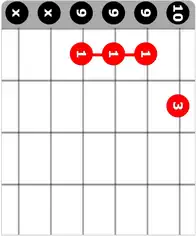
B6
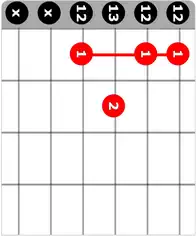
B7
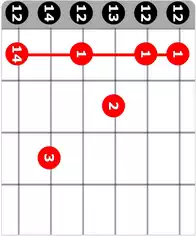
Chord Diagrams – E7 Chord Inversions
The chord diagrams below show the chord inversions I1, I2, and I3 of the E7 chord.
- First Inversion E7/G# with notes [G# B D E]. The Bass note is G#.
- Second Inversion E7/B with notes [B D E G#]. The lowest note is B.
- Third Inversion E7/D with notes [D E G# B]. The Bass note is D.
I1
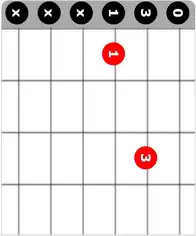
I2
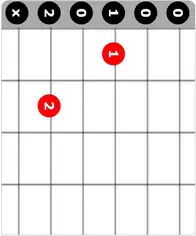
I3
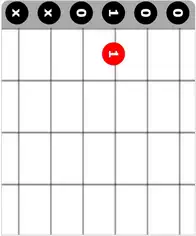
E7 Chord Piano With Keyboard Diagram.
The keyboard diagram in the root position for the E7 chord is shown below. Red circles mark the notes.

Fingering Arrangement
- Right Hand – 1 – 2 – 3 – 5.
- Left Hand – 5 – 3 – 2 – 1
The thumb is designated as ‘1’ and the little finger ‘5’ for both hands.
First Inversion
The keyboard diagram for the E7/G#, the first inversion, is shown below.

Fingering Arrangement
- Right Hand – 1 – 2 – 4 – 5.
- Left Hand – 5 – 3 – 2 – 1
Second Inversion
The keyboard diagram for the E7/B, the second inversion, is shown below.

Fingering Arrangement
- Right Hand – 1 – 2 – 3 – 5.
- Left Hand – 5 – 3 – 2 – 1
Third Inversion
The keyboard diagram for the E7/D, the third inversion, is.

Fingering Arrangement
- Right Hand – 1 – 2 – 3 – 5.
- Left Hand – 5 – 4 – 2 – 1
